When it comes to guitar effects, phasers, also known as phaser shifters, are among the most well-known and widely used. We’ve heard it on countless songs and riffs, and certainly classics like ‘Shine on you crazy diamond’ wouldn’t have been the same without the characteristic nasal swirl of the best phaser pedal. They were originally made to stimulate the sound of rotating organ speakers. But shortly, players found that they can make other core sounds too. If you want to add some life and movement to your sounds, a phaser will perform an excellent job of transforming a lengthy, monotonous sound into something more engaging.
Typically, a phase is made up of a series of notches lined up in a frequency spectrum. You can think of it as a progressive equalizer that automates frequency cuts by using an internal Low-Frequency Oscillator (LFO). In order to know the best phaser pedal for you, read on from here and get their differences.
Phraser Pedal Reviews
BOSS PH-3 Phase Shifter Guitar Pedal
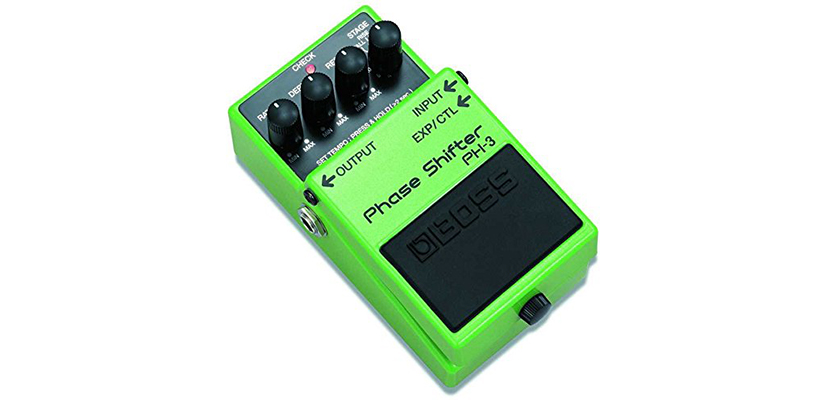
This is Bosch’s current shifter, which is a digital type. The previous ones, the PH-2 and the PH-1 were analog phasers. The Boss PH-3 is a more versatile phase shifter pedal and there are so many great things about it. So, the first thing I noticed was that it comes in the classic green Bosch stompbox format. The basic features include a control panel with four knobs on this particular pedal. Going from left to right, there’s the rate (speed) of the phase control, the second knob is the depth of the modulation, the third one is the resonance control (the resonance is the peak of the modulation). With the last knob, there are four stages. The stages indicate the number of notches out of the frequency that is being shifted back in by the phaser and include 4, 8, 10 and 12 phasers. The higher the stage number, the more points that will be phase shifted. Therefore, it will give a much more obvious and deep phase sound. And if it is a 4 stage, you’ll get a subtle sound. Another set of controls are the modes. There are three of them – fall, rise, and step. The modes help create a sort of unilateral phasing. Altogether, the Boss phaser sound effect is good.
Pros
- It is durable enough.
- A 5-year warranty.
Cons
- The digital version is a deviation from what most are familiar with. It really takes some getting used to.
MXR M290 Phase 95 Mini Guitar Effects Pedal
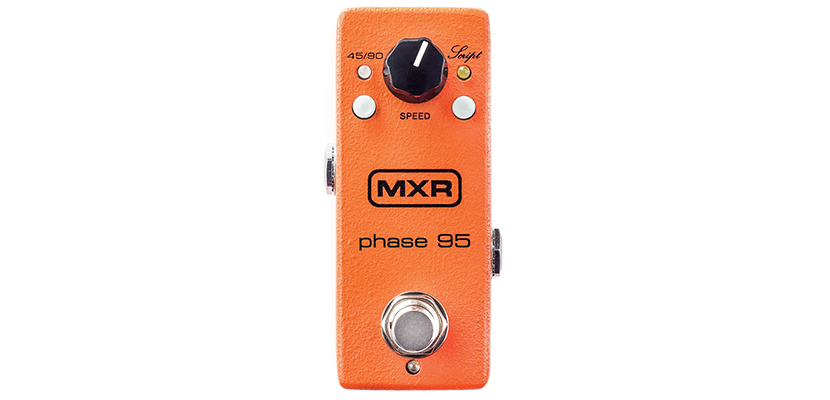
It’s interesting how MXR kind of squashed into this miniature version of phase 90 called phase 95. The MXR phaser, in fact, has a typical MXR design. And that’s an orange phase 90’s kind of finish. The only thing is that phase 95 has both phase 45 and phase 90 circuits built originally. This is because, after the release of phase 90, it took just a couple of years more before MXR rolled out phase 45 ( a two-pole model as opposed to a four-pole phaser – means a less obvious sound going on in phase 45). So, the features of the MXR phase 95 incorporate a switch which allows you to move between 45 and 90. The next is the LED lights. There are two – red and blue and they indicate which phaser you’re on. Then the script setting ensures a smooth change between the phaser sounds in 45 or 90 mode. Finally, there’s the speed control and the latching footswitch with a blue LED to show when the phaser is on/off. MXR’s decision to decrease the size of this phaser seems sensible to me.
Pros
- It comes with its own power supply.
- Very cost-effective for users.
Cons
- The cord weights more than the pedal itself.
- The script mode can be better because currently, it sounds too filtered.
- It is not beginner-friendly.
TC Electronic Helix Phaser Pedal
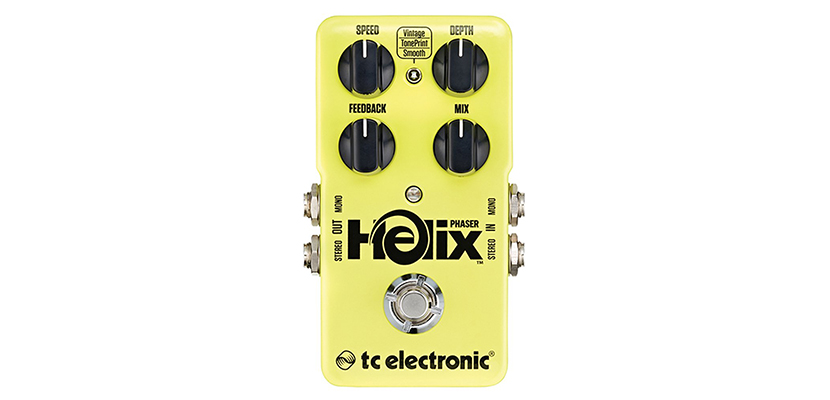
The original TC Electronic phase 12 was one of the TC ever did and dates all the way back to 1976. The TC phaser is today regarded as a classic, owing to its excellent 3D-like sound and immaculate noise-free operation. The big deal here’s that the Helix phaser recreates the sound of the original phaser 12 and has tons of flexibility as well as some fresh features. Additionally, as opposed to the standard MXR vintage 1974 phaser, the Helix phaser has more controls. Also, since MXR vintage has only speed control, introducing the Helix model is considered as an edge because it possesses speed, depth, feedback, and mix knobs. In turn, the controls enable users to fine-tune the sound precisely as they want it. It likewise affords the player a lot more options to use. Helix also sounds warmer and the dampening of the frequency seems to be a little bit higher. There are pretty much two modes – vintage and smooth, and of course, the tone print option which are enough to satisfy both the vintage fan and the sonic explorer looking for new creative inspiration.
Pros
- Available bypass buffer.
- It supports both input and output stereos.
Cons
- Sometimes there’s a disconnection between the wet and dry signals. As a result, the phaser effect becomes distorted and could be audible especially when performing in quiet halls.
- The TC Electronic requires an external power circuit.
Behringer Vintage Phaser VP1
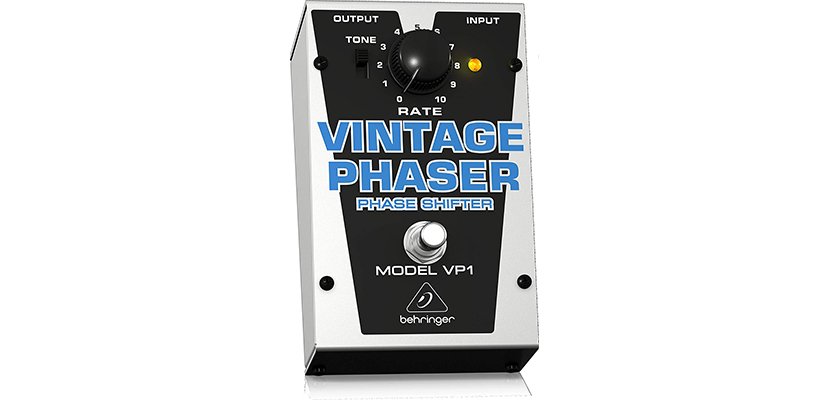
The VP1 vintage phaser features a big aluminum housing that is quite recognizable. This type, however, appears more rigid than it’s rivals. For instance, the features are more or less simple or casual making it. There aren’t many alternatives too. You will have to endure the strain of moving from one bass phaser to another. Well, a few things still make it worthy of buying. On the back, there’s the battery compartment which is pretty flimsy, while the non-clicking switch is positioned in the front. There’s another one on the upper part – the heavy tone switch which is more of an intensity switch. This is the switch that gives the signals negative feedback. On top, the input and output circuits are positioned. Then you have the rate control on a separate circuit board which moves in a wobbly fashion when touched. Other characteristics include a status LED, a bypass buffer (true hardwire), etc.
Pros
- Very affordable.
- It produces a wide range of effects when compared to the rest.
- The controls are quite responsive.
Cons
- Overall, the sound quality is not as good as the other phasers.
- The volume seems to die out while in use.
- The lower switch produces an abnormally loud sound when turned.
Empress Effects Phaser Guitar Effects Pedal
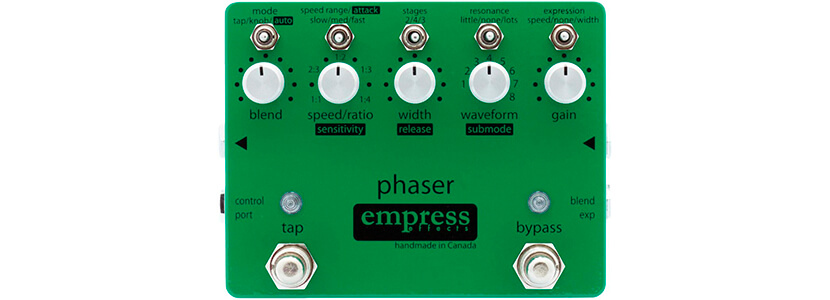
The Empress phaser is very clean and pristine by design. The auto modes stand out this model: Envelope, Trigger. and Rhythm. It has a signal to noise ratio of 104 which means the sound quality is really good. Through the universal control part, you can reach the three groups of deep switches, 3 depths which help set which midi channel will use. There’s a second group of 3 depths right next to the control port and they let you figure out what type of input should go into the control. In the middle, there’s a group of 4 depths with ‘blend’ written underneath them. It helps you alternate between the blend and mix knobs and also build your engagement with the harmonic circuit. The phaser allows the blend knob not to be set as the mix knob. This means that with the blend knob all the way clockwise, the wet and dry signals are mixed 50/50. The result is a maximum phase cancellation and the most pronounced effect.
When switching to mix mode, the Blend knob lets you configure the mix fully from a 100% dry to a 100% wet. The blend depth switch controls this feature. The mix knob, on the other hand, activated the vibrato mode. Turning it clockwise, on the other hand, will give you a 100% wet signal with no phase cancellations and sufficient modulation. The vibrato effect strengthens as you increase the width effect. The harmonic enhancement phaser adds some soft yet pleasing effects to the wet signal. This will undoubtedly give your phaser a more vintage feel. Extra features consist of True display LEDs and eight auto modes.
Pros
- Auto powered by a DC input.
- Very versatile.
Cons
- Not a good choice for simple learners.
- High price range.
ammoon KOKKO Electric Guitar Effect Pedal
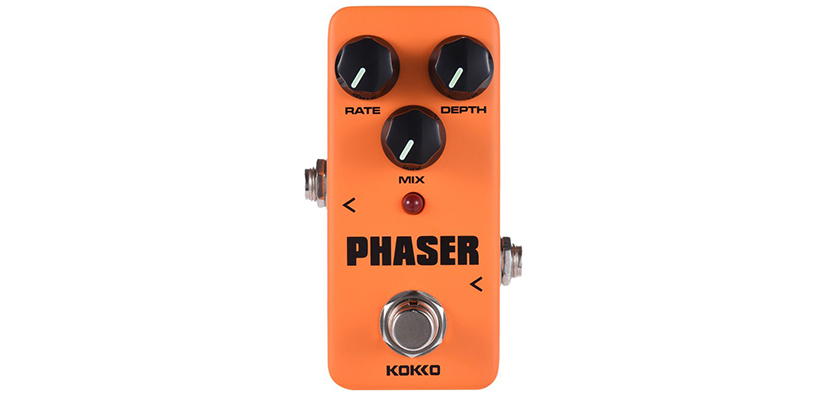
This is a bass phaser pedal and another inexpensive small phaser pedal that performs a good job of imitating the original MXR Phase 90 retro Phaser capabilities. Even the esthetics thoroughly complement its bright orange color. It features a full metal outer cover that is modeled on the original device. You just have to fashion the 3 knobs in the most effective way to meet your specific requirements, easy to use. Rate adjusts the speed levels, depth reduces the intensity and mix regulates the ratio of wet to dry signals. I would describe it more as a fresh lift essentially. It’s very much like the MXR Micro Amp booster with a single knob but somewhat more flexible than the micro amplification. The distinction is that you have the bass and adjust volume settings. Plus you still get a volume boost at the lowest setting of the gain button. I did set my volume of the tube (6L6 to 2 amp) for use at home, but if you want to aim for a cleaner sound, then set it to 8 amp. Overall, it’s fairly clean until around halfway through, when you may notice an amp breakdown in the volume knob.
Pros
- Wide range of harmonics.
- There are indicated dimensions for fixing the pedalboard.
- Easy to operate.
- Good price.
Cons
- Not a versatile model.
Joyo JF-06 Vintage Phase Guitar Pedal
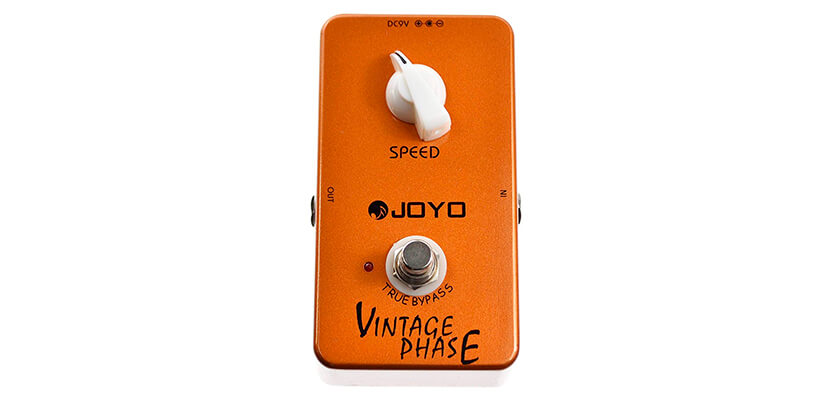
The Joyo vintage phaser is essentially an MXR phase 90 clone. Both pedals can produce a wide range of sounds. This pedal will be a great substitute for a wire pedal. The phaser is an example of a classic analog. It’s equipped with speed control. The low-speed phase works well for bringing life to rhythm or lead leaks. The high-speed phase supports overdrive and the medium speed phase. The phaser is very easy to use and has only one control knob and that is the rate (I mentioned it above). There is just one on/off switch. This variant embodies the classic 70s pedal style. Just like the Ammoon Kokko phaser, it is a miniature model. It comes with a true bypass wiring and a 9-volt battery.
Pros
- A fair price to buyers.
- Great sound quality.
- Portable.
Cons
- It can be damaged easily.
EarthQuaker Devices Grand Orbiter V2 Phase Pedal
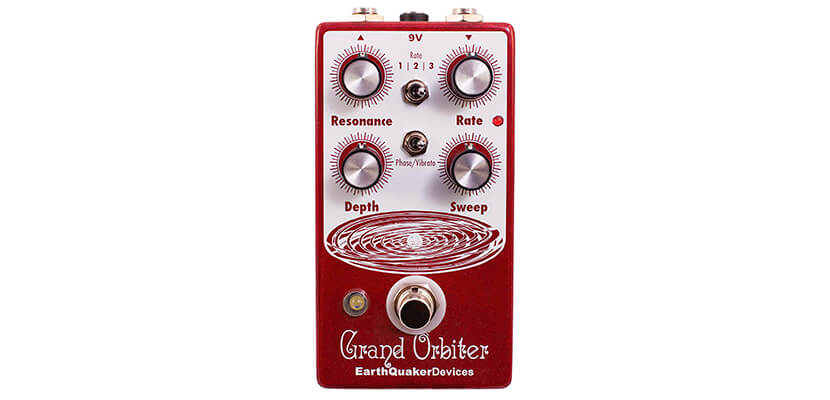
Few effects in this world give the same sound like a decent Grand Orbiter. It is, in fact, a four-stage phaser that gives you vibrato as well. The four controls are the resonance which takes care of the phased signal. The more the resonance tilts to the clockwise direction, the more subtle the counterclockwise would be. Then the rate control has 1,2, and 3 levels. The rate 1 is slow, 2 is an LFO that goes through the fixed filter and rate 3 is the fastest mode of all. The LED shows exactly how fast you’re going. The depth is usually a combination of wet and dry signal control. But when the phaser is in vibrato, the depth changes its role to a volume control. The sweep knob regulates the peaking of the phaser. Clockwise means higher and anti-clockwise suggests a lower frequency.
Pros
- Completely analog.
- The new footprint is much superior than that of previous versions.
Cons
- Pricier than most phaser shifters.
Buyer’s Guide
A Phaser: What is It?
In order to fully comprehend what a phaser is, we must first get a knowledge of how phaser pedals affect the sounds they produce. When there are two unsynchronized (out of phase because one note is slightly shifted) notes, a phaser can be used to shift further the notes until they cancel out each other. The result is the reorganization of a more harmonious effect. At this point, it’s safe to say that a phaser is a modulation pedal where instead of regulating the pitch (like a vibrato pedal will do) or modulating the volume (like tremolo would do), what it does is to control the phase. In other words, it produces a swirling or phaser sound effect. In total, phasers are used in all various types of music from metal to country to reggae.
Early phasers had just one or two controls, usually, just rate or sometimes depth. Now, most modern phasers have four controls– rate, depth, resonance, and effect level or mode, depending on what the phase can do. At times, you could come across other names of the controls, still, they have the same functions. Here’s what they do.
- Rate. It makes the phaser faster or slower.
- Depth. Depth makes the effect more intense and that’s why it could also be valued the intensity.
- Resonance. This control emphasizes certain tones in the switch.
- Modes. Modes are referred to as stages by Bosch. The reason is that they produce the sounds of different kinds of phase shifters – 4,8, 10, and 12 stage phasers. Classic and vintage phase shifters have a different amount of phase shifts, so, with it, it is possible to reproduce the sound of different classic phasers by selecting different stage settings. For each stage, there’s an extra frequency notch to the phaser sound. The frequency cancellation occurs in the notch. The more notches there are, the more the frequency is canceled and the more the phaser effect will be.
What does a Phaser Effect Mean?
Most musicians at some point have heard of a flanger or phaser, but they don’t really understand what’s actually going on when the bypass button is pushed. This is understandable due to the abstract nature of the phaser effect. The main thing about an effect is that it confers a swirling kind of hollow spacey sound that sweeps up and down the frequency spectrum. By this means, it adds life and richness to the guitar.
The best phaser pedals should be capable of producing a wide range of phaser effects in order to improve the overall sound quality of the guitar. When compared to other shifters – the flanger acts like a phase shifter but can change the sound much more dramatically. Also in a flanger, a pulse is separated into two parts, one of which is only marginally delayed in duration, typically not more than 20 milliseconds. The delays can also be controlled by a knob at a regular rate. Chorus pedals on the flipside, operate very well in stereo-based systems where the effect is created by two big amplifiers. It has a distorted 3D influence on the ears of audiences when used.
What are the Ways to Use a Phase Shifter?
If you just got a phaser or user curious, below is a guide on how to use phaser.
- Use as a clean melody lay up. Since humans can’t hear frequency oscillations below 20Hz, Low-Frequency oscillations are usually below 10Hz. The center frequency is one in which the phaser revolves around. This parameter determines where the middle of the phaser will be on the spectrum. So, it shifts all notches either up or down a frequency. Using a phaser more of work in parts. For example, to create an offset of the center frequency for the left and right channels, you can widen the stereo image with an LR (left-right) offset. This simply sends different phasing signals to both the left and right channels.
- Use as a clean chord progressor. Similarly, the phaser pedal is used as a rhythm guitar player in order to organize chord progressions. Unless you leave the phaser pedal down and get the pulse setting right, it wouldn’t reach its optimal sound performance. You can check for a smooth modulation in between any point at which the swirl slows down and becomes only slightly audible. However, you should maintain the speed and depth of the click is small to do the job.
- Use to thicken solos. Although phaser pedals do not combine with high distortions or power chords, a phaser footprint can be complemented with a lighter overdrive and disintegration, particularly to adorn some kind of solo or lead melody. In this case, combining the pulse and slow phaser settings works better, even if it depends on many other variables that we can not predict here, of course.
How does a Phaser Function?
So, how does a phaser work? Phase shifters work by using special filters that can change the frequencies they filter over time. This creates the soft moving sounds that phases are famous for. The more filters there are, the more the phase is shifted.
The key idea behind a phaser is that it shifts out-of-phase notes until they cancel out each other. No doubt, real guitar notes aren’t simple sine waves. They are complex waves formed from many types of frequencies at once. This means there’s a need for a total cancellation. Well, since there aren’t any uses for out-of-phase sounds appear to be in a static manner, it makes musical sense to shift a duplicated wave against an original. This stimulates a pulsing effect between the waves. The final picture will be two waves that reinforce each other in the in-phase and destroying each other when out of phase. It’s important to take note of the differences between the functioning of an analog phaser and the digital variant. The analog phaser uses a physical plug-in whereas the latter utilizes signals from a computer processor or a set of algorithms.

Hi everyone! I’m Thomas Moody, also known as Guitarzan.
